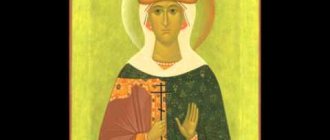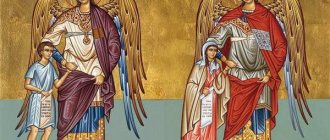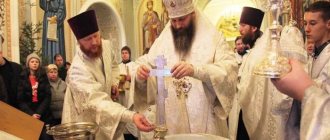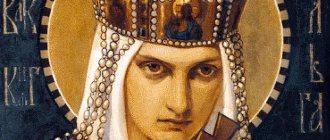Childhood
Ulyana herself was a completely ordinary, real woman of simple origin. Besides, she wasn't even a nun. Most likely, for this reason, Juliana was not as revered by believers as other saints with a church past. With the advent of Soviet times, her name was almost completely forgotten.
If you look at the life of Ulyaniya Osoryina superficially, then it is no different from the lives of other women of that time.
The saint was born in the 30s of the 16th century into a wealthy family in Moscow. Her father Ustin Nedyurev was a famous person in the city, as he served as a housekeeper in the palace of Ivan the Terrible.
When the girl was six years old, she was orphaned, and her grandmother took her to Murom. From childhood, the girl was a very modest child who believed in God. So, she did not like to play with children, devoting all her time to handicrafts and prayer.
When the girl was sixteen years old, she was betrothed to the nobleman Georgy Osoryin. After the wedding, she began to live four kilometers from the city in her husband’s estate, the village of Lazarevo.
The obedient and kind girl was liked by her husband's relatives, and therefore she was entrusted with running the household. From then on, she began a life familiar to women of her circle at that time.
Angel Ulyana Day by month
Ulyana celebrates her name day 15 times a year. Once a year there is a special name day - the day of the patron saint after whom it was named. If Ulyana does not know in whose honor she was named, her patron is the saint whose day of veneration her birthday is closest to. Or the saint whom she chose as her patron herself.
New martyrs are Christian saints who have been canonized since the 20th century, many in 2000. Since a person’s heavenly patron can only be a saint who was canonized before the date of his baptism or birthday, when choosing your patron angel, pay attention to the date of canonization of the new martyr.
January January 3
: Juliania of Nicomedia, martyr, virgin Juliania of Vyazemskaya, Novotorzhskaya, martyr, princess
January 15
: Juliania of Lazarevskaya, Murom
March March 17
: Juliana of Ptolemais, martyr
April April 2
: Juliana of Amisia (Pontus), martyr
May May 16
: Juliania of Moscow
June June 15
: Juliania Vyazemskaya, Novotorzhskaya, martyr, princess (discovery of relics)
July July 5
: Juliania, martyr
July 19
: Juliania Olshanskaya, Pecherskaya, princess, maiden
August August 30
: Juliana of Ptolemais, martyr
August 31
: Juliana, martyr
October October 11
: Juliania Olshanskaya, Pecherskaya, princess, maiden (Pecher. B.)
November November 14
: Juliana of Rossona, martyr
December December 17
: Juliana of Iliopolis, martyr
Works and charity
But, despite all the household responsibilities, Juliana did not become less devout. She woke up at night to pray, making multiple bows. Since she could not manage her husband’s property, she devoted all her free time, including the night, to needlework in order to help those in need with the proceeds.
She donated skillfully embroidered canvases to the church, and sold other work in order to be able to help the poor. She did all her good deeds in secret from her loved ones, sending her maid to deliver alms to the poor at night.
She took special care of orphans and women left without husbands. Thanks to constant work, Juliana was able to support many families. After some time, she became known as the “nun of the world,” a benefactor and savior of all those in need.
The evil one doesn't like it
St. Nicholas Embankment Church in Murom, where at one time there were the honest relics of St. Juliana.
Today the relics of Saint Juliana are in the Church of the Annunciation of the Virgin. Photo: muromru.ru Once in a dream, crafty spirits threateningly warned Juliana that she would soon die if she continued to help. Enough of her household chores! The saint did not attach much importance to this dream, since she could not imagine her life without helping those in need.
After all, gradually for her people stopped dividing into friends and strangers, and everyone who suffered became one of their own.
Family life
Juliana lived with her husband for many years in love, and gave him 13 children: three girls and ten boys. True, six of them died in early childhood, and two died later, already in adulthood.
After their death, Juliania decided to go to a monastery, which she told her husband and relatives about, asking their permission. However, her husband refused her this, saying that she had more children who needed to be raised and educated. But after this conversation, he allowed her not to perform marital duties.
Since Juliana was accustomed to living in meekness and obedience to her husband, she agreed, once again showing respect for her husband and demonstrating Christian humility. She worked all day long around the house, and prayed all night, leaving only two to three hours for sleep.
Difficult years
After the saint buried her husband, she became even more involved in charity work. She gave all the property she inherited from her husband to those in need. At the same time, she was content with little and soon reached extreme need.
During the time when Boris Godunov was in power (1601-1603), famine came to Murom. That summer was very rainy, and in August the frost had already hit, so the harvest was not ripe. Famine also came to Juliana's house. But despite this, the woman continued to feed the poor, baking bread from tree bark and weeds. In addition, the bread that Julianna baked became not only edible, but also acquired an unusually sweet taste.
Soon Juliana fell ill, but she also continued to get up for night prayer. Before her death, she admitted that she had long wanted to have the image of an angel, but her sins stopped her. Everyone who was present at the death of Ulyana noticed a halo-like golden glow around her head. The righteous woman died in 1604 on January 15. Saint Juliana was buried, according to her will, in Lazarevo.
Life
Brief life of the martyr Juliana of Nicomedia
The Holy Martyr Juliana, the daughter of the noble pagan Africanus, was born in the city of Nicomedia. At the age of nine she was engaged to a certain Eleusius. Possessing a deep intelligence and a soul inclined to goodness, Saint Juliana understood the illusory nature and deception of the pagan faith. She secretly received Holy Baptism. When the time for the wedding approached, Juliana resolutely refused to marry. Her father began to persuade her not to break her long-standing engagement, but, not achieving what he wanted, he began to brutally beat her. Then Africanus gave his daughter to the eparch of the city, who was Eleusius, the former groom of Juliana. Eleusius fervently asked Juliana to marry him, promising not to force her to change her faith. Saint Juliana refused and chose to accept torture. The saint was tortured for a long time and cruelly, but after each torture she received healing and new strength from God. The torture was carried out in front of a large number of people, of whom 500 husbands and 130 wives, seeing the inflexibility and courage of the holy virgin and her miraculous healings from her wounds, confessed Christ. They were beheaded, baptized in their own blood. Having finally become convinced of the complete failure of attempts to turn the holy virgin away from her Heavenly Bridegroom, Eleusius sentenced Juliana to death. The confessor accepted the verdict with joy and glorified the Lord, who made her worthy to receive the crown of martyrdom. The execution of the holy martyr Juliana took place in 304.
Complete life of the martyr Juliana of Nicomedia
Martyr Juliana, the daughter of rich pagans, was born in the city of Nicomedia (in Asia Minor) in the year 286. At the age of nine, Juliania's father, Africanus, betrothed her to a noble and wealthy young man, Eleusius, the son of a court nobleman. Due to the young age of both, the marriage was postponed until they came of age. Over the years, Juliana learned about the Christian faith, believed and was baptized. Eleusius advanced through the civil service and became the ruler of Nicomedia. When the time for marriage approached, Juliana began to tell her pagan fiancé about the Christian faith and persuade him to be baptized. When Eleusius refused, Juliana also refused to marry him.
The rude and unbridled Africanus, having learned that his daughter had joined the sect of Christians he despised and refused such an enviable groom, became very angry with her and began to beat her. Juliana said to her father: “I honor Christ, I love Christ, and I am not afraid of torment for Him.”
Then Africanus gave his daughter to Eleusius himself for trial. Enchanted by the beauty of his former bride, Eleusius at first gently persuaded her to renounce Christ and marry him. Then, seeing her firmness, he began to threaten her with various tortures. But neither the promises of worldly blessings nor the fear of death could force Juliana to renounce Christ. She was severely scourged and then thrown into prison. Here, a new test awaited Juliana: the devil appeared to her in the form of a bright angel and began to convince her to show prudence and make a small compromise. Guessing from the speeches that the enemy of the human race was speaking to her, Iualiania prayed to God, and the devil disappeared in shame.
Seeing the firmness of the martyr of Christ and the miracles performed during her torture, many residents of Nicomedia believed in Christ. They were all beheaded. After this, Saint Juliana, who was then 18 years old, was also executed. This happened in the year 304.
The Martyr Juliana is revered as the patroness of chastity and virginity. Pieces of her relics are kept in many temples.
Relics of Juliania Lazarevskaya
Ten years later, in 1614, Juliania’s son, George, died. When they dug a grave for him, they found the relics of the saint, which not only exuded myrrh and emitted a fragrance, but also healed the sick, especially children. In the same year, the church decided to canonize Juliana, and the righteous one was canonized.
The life of the descendants of Saint Juliana also did not pass without a trace. One of them, Georgy Mikhailovich Osorgin, was shot on the Solovetsky Islands, as Solzhenitsyn wrote about in his work “The Gulag Archipelago.” Another of her descendants, Nikolai Mikhailovich Osorgin, lives in Paris and works at the Orthodox Theological Institute with the rank of professor. In addition, he is the author of several books, as well as the regent of the Sergievsky metochion, which was founded by his grandfather.
The holy relics of Juliana were kept in the church in the village of Lazarevo, but in 1930 the temple was closed. The tomb with the remains of the righteous woman was moved to the local museum and placed next to the tombs of the Murom holy spouses Peter and Fevronia.
In 1989, the saint’s relics were returned to the Orthodox Church. Now they are in the St. Nicholas Embankment Church in the city of Murom.
Currently, the temple erected in honor of the Archangel Michael in the village of Lazarevo (6 km from Murom), where the saint was buried and her relics were located until the 1920s, is also being restored. There are holy miraculous springs in the village. This place is currently the courtyard of the Murom Spaso-Preobrazhensky Monastery.
On August 23, 2004, the Day of Charity and Mercy was celebrated for the first time. The celebration was blessed by Patriarch of All Rus' Alexy II.
In 1604 (400 years ago), the holy righteous Juliana Lazarevskaya (Osoryina), who became famous for her amazing kindness and ascetic lifestyle in the world, died. And ten years later, and precisely on this day, August 10/23, 1614, the relics of the saint were found, and she was canonized.
That is why, a new feast of mercy for our country was established on August 23, the day when the remains of St. Juliana of Murom were found.
I would like to note another amazing holiday, which is also celebrated in the summer on Murom land: July 8 - Day of Family, Love and Fidelity. It acquired All-Russian status in 2008.
Every summer, on the eighth of July, the church and all believers remember the life of the holy spouses, who are examples of true love and family fidelity. This is precisely what explains the second name of the holiday - the Day of Peter and Fevronia of Murom.
To get the most out of the city and its surroundings, I recommend booking an apartment, room or hotel for one or more nights. You can easily rent daily accommodation in Murom on Airbnb, or book a hotel through Booking.
Sights of the city of Murom and its environs, where I was able to visit, are on this map. For a detailed description of each of them, see here.
Share in the comments what sights of Murom you visited and which of them made the strongest impression.
Bibliography[ | ]
- Rudi T.R., Sokolova L.V. Osorin Kallistrat (Druzhina) Georgievich // Dictionary of scribes and bookishness of Ancient Rus'. Vol. 3: XVII century, part 2: I-O / * ed. D. M. Bulanin, A. A. Turilov. - St. Petersburg: Dmitry Bulanin, 1993. P. 429-433
- Fedotov G.P. Collected works in 12 volumes. T. 8: Saints of Ancient Rus'. M.: Martis, 2000. P. 179-182
- Buslaev F.I. Ideal female characters of Ancient Rus' // Buslaev F.I. About literature. Research. Articles. M., 1990. S. 262-294
- A. V. Kuzmin, O. A. Sukhova.
Juliana // Orthodox Encyclopedia. - M., 2012. - T. XXVIII: “Historical Museum - Yekuno Amlak.” — P. 545-555. — 752 p. — 39,000 copies. — ISBN 978-5-89572-025-7.








